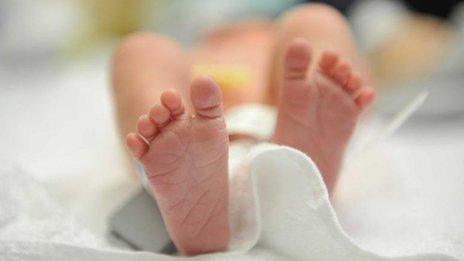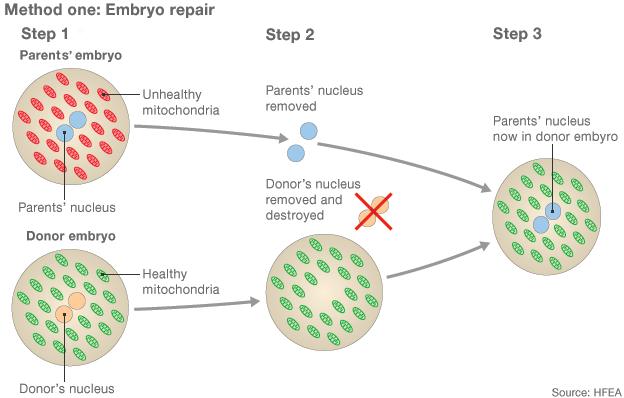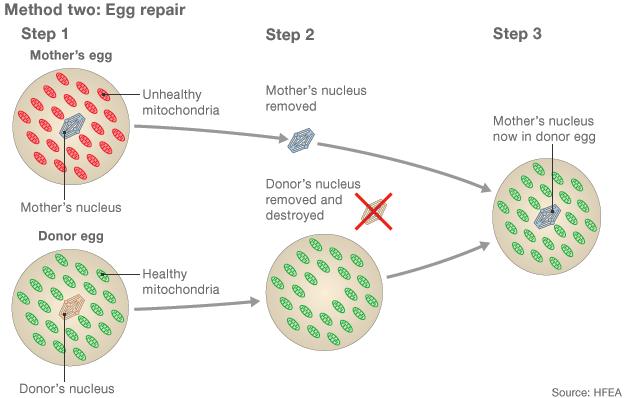Three-person IVF moves closer in UK
- Published
- comments

The UK has moved closer to becoming the first country to allow the creation of babies from three people.
The Human Fertilisation and Embryology Authority (HFEA) has advised the government that there is no evidence the advanced forms of IVF were unsafe.
The fertility regulator's public consultation also showed "general support" for the idea as the benefits outweighed the risks.
A final decision on whether to press ahead rests with ministers.
If the techniques were approved it could help a handful of families each year. Around one in 6,500 children develop serious "mitochondrial disorders" which are debilitating and fatal.
Research suggests that using mitochondria from a donor egg can prevent the diseases.
However, it would result in babies having DNA from two parents and a tiny amount from a third donor.
Concerns have been raised both about the safety and the ethics of creating such babies.
The results of a public consultation at the end of 2012 showed there was support for the idea.
Prof Neva Haites, who was on the expert panel supervising the consultation, said: "Broadly speaking the public was in favour of these novel techniques being translated into treatments.
"They felt that any ethical concerns were outweighed by potential benefits."
One of the main issues raised was of a "slippery slope" which could lead to other forms of genetic modification.
'Power stations'
Mitochondria are the tiny biological power stations that give energy to nearly every cell of the body.
Defects can leave the body starved of energy, resulting in muscle weakness, blindness, heart failure and death in the most extreme cases.
The cigar-shaped mitochondria are passed only from mother to child. A father does not pass on his mitochondria through his sperm.
Scientists have devised two techniques that allow them to take the genetic information from the mother and place it into the egg of a donor with healthy mitochondria. It is like taking two fried eggs and switching the yolks.
How would it work?

1) Two eggs are fertilised with sperm, creating an embryo from the intended parents and another from the donors 2) The pronuclei, which contain genetic information, are removed from both embryos but only the parents' is kept 3) A healthy embryo is created by adding the parents' pronuclei to the donor embryo, which is finally implanted into the womb

1) Eggs from a mother with damaged mitochondria and a donor with healthy mitochondria are collected 2) The majority of the genetic material is removed from both eggs 3) The mother's genetic material is inserted into the donor egg, which can be fertilised by sperm.
The result is a baby with genetic information from three people, as mitochondria have their own genes in their own DNA.
The implications are not just for the couple and the child. If the therapy was performed it would have ramifications through the generations as scientists would be altering human genetic inheritance.
'Recommendations'
The HFEA has advised that any changes to the law should be only for the modification of mitochondria to overcome serious diseases and that there should still be a ban on changes to the main nuclear DNA, which contains the vast majority of a person's genetic code.
It also recommended continuing research and that any children born through these techniques, and possible the children's children, be monitored closely.
There was vigorous discussion at the HFEA Open Meeting, where the advice to ministers was agreed, around issues of identification. In sperm and egg donation the donor is identified.
The meeting agreed to advise ministers that there should be no right for the child to know the identity of the donor, however, the HFEA will tell ministers that public opinion was mixed.
Mr Hossam Abdalla, clinical director of the Lister Fertility Clinic in London, told the meeting: "If a child wants to know about that, why are we so restrictive... why are we telling them we they can't have this access?"
'Astounded'
Prof Lisa Jardine, chairwoman of the HFEA, said the UK was in one of the most advanced positions in the world.
"Other countries are astounded that we're this far on in the discussions," she said.
However, she pointed out the techniques would be used only for mitochondrial disorders: "This is not a Rubicon or a slippery slope."
One of the pioneers of the field, Prof Doug Turnbull, from Newcastle University, said: "The techniques we are working on could help hundreds of women have healthy children."
He said more research was required, but it was now "crucial" that the government approved the techniques in the UK.
The Department of Health said mitochondrial diseases could have a "devastating impact" on families and it would consider the HFEA's advice.
Making three-person IVF legal would not require a new act of Parliament, but would require a vote in both the Commons and the Lords.
Mother: I can't just go and get pregnant
Speaking after the meeting Dr David King, the director of Human Genetics Alert, said: "Historians of the future will point to this as the moment when technocrats crossed the crucial line, the decision that led inexorably to the disaster of genetically engineered babies and consumer eugenics.
"This was the moment at which they casually tossed the bioethical consensus of the last 30 years into the trash. And for what?
"Not so mothers could avoid having sick babies, because they could do that already, through egg donation. It was so that a few dozen mothers who insisted they must be genetically related to their child could be satisfied."
- Published20 September 2012
- Published17 September 2012
- Published17 September 2012
- Published12 June 2012
- Published19 January 2012
- Published11 March 2011